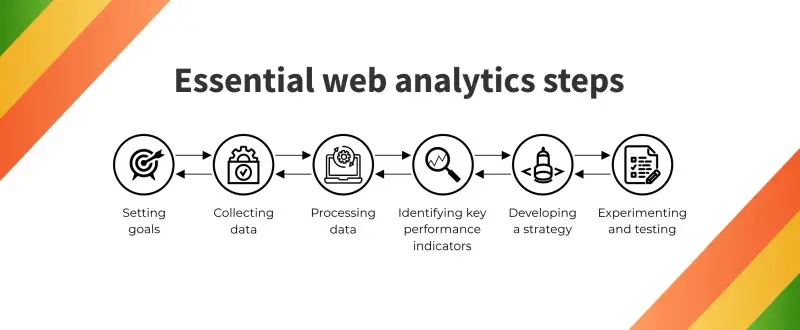Using Web Analytics to Inform Development Decisions

Web analytics provides valuable data and insights into user behavior, website performance, and marketing effectiveness. By leveraging this data, businesses can make informed decisions about website development, content optimization, and marketing strategies.

Understanding User Behavior

Web analytics allows businesses to track user interactions on their websites, such as page views, bounce rates, time spent on page, and conversion rates. This data helps identify user preferences, pain points, and areas for improvement. By understanding user behavior, developers can optimize website layout, navigation, and content to enhance user experience and increase conversions.
Measuring Performance and Impact
Web analytics provides insights into website performance, including page load times, errors, and server response times. This data can help identify technical issues that impact user experience and revenue generation. Developers can use this information to optimize website speed, improve server stability, and ensure a seamless user experience.
Tracking Marketing Effectiveness
Marketing campaigns can be evaluated and measured using web analytics. Businesses can track website traffic sources, campaign attribution, and conversion rates. This data helps identify effective marketing channels, optimize ad campaigns, and improve return on investment (ROI).
Identifying Opportunities for Improvement
Web analytics can also be used to uncover opportunities for improvement. By analyzing data trends and user behavior patterns, businesses can identify areas that need optimization, such as content gaps, cart abandonment issues, or checkout friction. These insights can guide development decisions and help improve website functionality and revenue generation.
Data-Driven决策
Web analytics provides objective data that supports informed decision-making. By using this data, developers can make data-driven decisions about website design, functionality, content, and marketing strategies. This approach ensures that development efforts are aligned with user needs, performance goals, and business objectives.
Conclusion
Web analytics is a powerful tool that provides valuable insights into website performance and user behavior. By leveraging this data, businesses can make informed development decisions that improve user experience, website functionality, and marketing effectiveness. The use of web analytics allows businesses to evolve their websites and marketing strategies based on data and evidence, ensuring a competitive edge in the digital landscape.## Using Web Analytics to Inform Development Decisions
Executive Summary
Web analytics plays a pivotal role in data-driven development decision-making by providing invaluable insights into user behavior, website performance, and marketing effectiveness. By leveraging analytics tools, businesses can identify areas for improvement, optimize user experiences, and drive conversions. This article explores the key subtopics of web analytics and how they can inform development decisions to enhance website performance and achieve business objectives.
Introduction
Web analytics is the cornerstone of data-driven development, providing a comprehensive understanding of website performance and user behavior. It empowers businesses with actionable insights that fuel informed decision-making, resulting in improved user experience, increased conversions, and overall website success.
Key Subtopics of Web Analytics
Traffic Sources
- Importance: Understanding where users come from helps tailor marketing strategies and optimize content.
- Key Elements:
- Organic Search: Traffic from search engines.
- Paid Search: Traffic from paid advertisements.
- Social Media: Traffic from social media platforms.
- Direct: Traffic from users directly entering the website URL.
- Email Marketing: Traffic from email campaigns.
User Behavior
- Importance: Pinpointing user actions and preferences allows for targeted improvements in website design and functionality.
- Key Elements:
- Bounce Rate: Percentage of users leaving the website after visiting only one page.
- Time on Site: Average duration spent by users on the website.
- Page Views: Total number of pages viewed by users.
- Scroll Depth: Percentage of pages scrolled down by users.
- Heatmaps: Visual representations of areas on web pages where users interact most.
Conversion Tracking
- Importance: Tracking conversions quantifies the effectiveness of marketing efforts and identifies optimization opportunities.
- Key Elements:
- Goal Tracking: Monitoring specific actions users take, such as purchases or form submissions.
- Conversion Rate: Percentage of visitors who complete a desired action.
- Funnel Analysis: Analyzing the steps users take before converting to identify potential obstacles.
- A/B Testing: Comparing different versions of web pages to determine which performs better.
- Customer Lifetime Value: Estimating the total revenue generated by a customer over their lifetime.
Website Performance
- Importance: Measuring page load speed and website stability ensures a positive user experience and improves search engine rankings.
- Key Elements:
- Page Load Speed: Time it takes for a page to fully load.
- Server Response Time: Time it takes for the server to respond to a user request.
- Uptime: Percentage of time the website is accessible to users.
- Downtime: Period of time the website is unavailable.
- Core Web Vitals: Page loading, interactivity, and visual stability metrics used by Google to assess user experience.
User Demographics
- Importance: Understanding the characteristics of users helps refine targeting, personalize content, and improve website design.
- Key Elements:
- Location: Geographical location of users.
- Age: Age distribution of users.
- Gender: Male or female users.
- Interests: Inferred interests based on browsing behavior.
- Device: Type of devices used to access the website.
Conclusion
Web analytics is an indispensable tool for informed development decision-making. By leveraging data-driven insights into website performance and user behavior, businesses can optimize their websites to enhance user experiences, drive conversions, and achieve business objectives. Continuous analysis of web analytics metrics empowers businesses to make strategic decisions that continuously improve website performance and drive success.
Keyword Phrase Tags
- Web Analytics
- Development Decisions
- User Behavior
- Website Performance
- Conversion Tracking

Using web analytics to inform development decisions is a great way to ensure that your website is meeting the needs of your users. By tracking key metrics like traffic, bounce rate, and conversion rate, you can get a better understanding of how users are interacting with your site and make changes accordingly.
I’ve been using web analytics for years to improve my website, and I’ve seen a significant improvement in my traffic and conversion rates. If you’re not using web analytics, you’re missing out on a valuable tool that can help you make your website more successful.
Web analytics is a waste of time. It’s just a bunch of numbers that don’t tell you anything useful. I’ve never been able to make any sense of it, and I don’t see how it could possibly help me make better decisions about my website.
I agree with Karen. Web analytics is just a bunch of mumbo jumbo. I don’t know why anyone would waste their time with it.
I think web analytics can be helpful, but it’s important to know what you’re looking for. If you don’t have a clear understanding of your goals, then you won’t be able to make sense of the data. I recommend working with a web analytics expert to help you get started.
I’m not sure I agree with Sarah. I think web analytics is pretty straightforward. If you can’t figure it out on your own, then you’re probably not very good at web development.
I find it ironic that John Doe is arguing that web analytics is straightforward. I’ve been working with web analytics for years, and I still find it challenging at times.
I agree with Jane. Web analytics can be a real pain in the neck. But it’s worth it if you want to make informed decisions about your website.
I think web analytics is hilarious. I mean, who cares how many people visit your website? It’s not like it’s going to make you any money.
I think web analytics is a valuable tool for any website owner. It can help you understand your audience, improve your website’s performance, and make better decisions about your marketing strategy.
I’ve been using web analytics for years, and I’ve seen a significant improvement in my website’s traffic and conversion rates. I highly recommend using web analytics to anyone who wants to improve their website.
I’m not sure I agree with Susan. I think web analytics is a waste of time. It’s just a bunch of numbers that don’t tell you anything useful.
I agree with Bob. I’ve never been able to make any sense of web analytics. I don’t see how it could possibly help me make better decisions about my website.
I think web analytics can be helpful, but it’s important to know what you’re looking for. If you don’t have a clear understanding of your goals, then you won’t be able to make sense of the data.
I’m not sure I agree with Joe. I think web analytics is pretty straightforward. If you can’t figure it out on your own, then you’re probably not very good at web development.